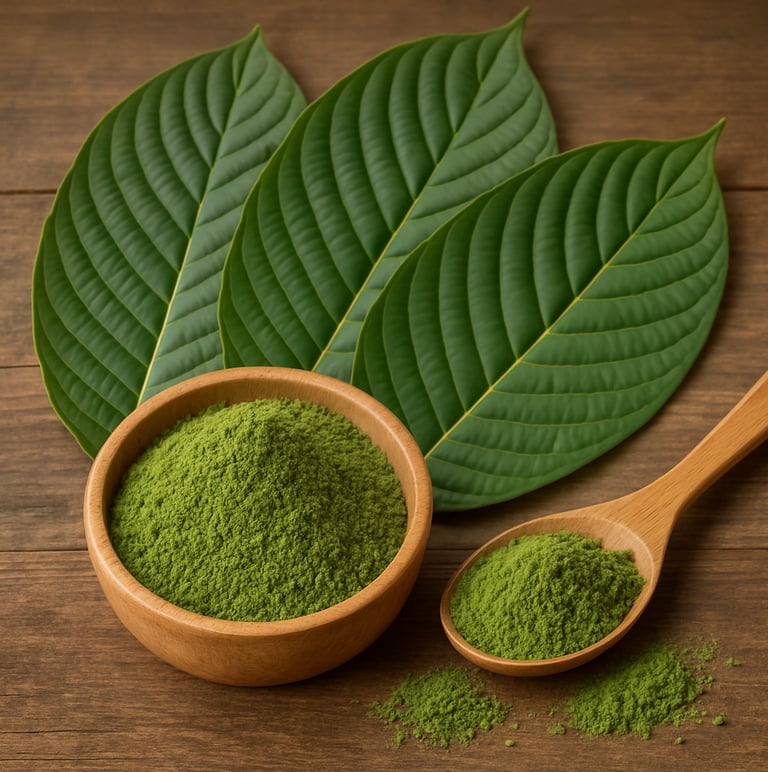Stay updated on what is trending in health. Discover tips and resources for a healthier, balanced life.
Mitragynine Toxicity: What You Need to Know About Kratom Overdose and Safety
Worried about mitragynine toxicity? Learn how the kratom compound affects your body, side effects, overdose signs and safety tips on kratom or mytragynine and how to stay safe.
WELLNESS
Dr. S. Ali
10/15/20257 min read


Let’s Talk About Kratom — and Its Risks
You’ve probably heard of kratom, a plant-based supplement gaining popularity for pain relief, mood boosts, and even help with opioid withdrawal. It’s natural, yes — but does that mean it’s always safe?
Not necessarily. The main active ingredient in kratom is mitragynine, and while it can offer benefits, it can also be harmful — even toxic — at high doses. In this article, we’re going to unpack mitragynine toxicity in plain, easy-to-understand terms.
If you or someone you know uses kratom, read on. Understanding how mitragynine works — and when it can become dangerous — is key to using it responsibly (or avoiding it altogether).
What Is Mitragynine?
Mitragynine is the primary active compound found in the leaves of the Mitragyna speciosa plant, better known as kratom. It acts on the brain’s opioid receptors, which means it can have effects similar to opioids — pain relief, euphoria, and sedation.
The Mitragyna speciosa plant, commonly known as kratom, is native to Southeast Asia. It thrives in tropical regions, particularly in countries like:
Thailand
Malaysia
Indonesia (especially Borneo and Sumatra)
Myanmar (Burma)
Papua New Guinea (less common)
It grows in humid, jungle-like environments and has been traditionally used for its stimulant and pain-relieving effects.
People use kratom for:
Pain management: Kratom is commonly used as a natural alternative for relieving chronic or acute pain due to its alkaloids that interact with opioid receptors.
Anxiety or mood improvement: Some users take kratom for its calming effects, which may help reduce anxiety and promote a sense of well-being.
Energy boosts (at low doses): In smaller amounts, kratom can act as a stimulant, increasing alertness and energy levels.
Relief from opioid withdrawal symptoms: Kratom is sometimes used to ease withdrawal effects from opioids, as it can mimic some opioid-like effects while being less potent.
Sounds like a wonder herb, right? But there’s a catch.
The Dose Makes the Poison
Here’s where things get tricky. At low doses, mitragynine may act like a stimulant. But at higher doses, it acts more like a sedative or opioid. And when taken in large amounts, or combined with other substances, mitragynine toxicity can occur.
This means:
Nausea
Confusion
Seizures
Slowed breathing
Even death, in severe cases
Just because something is plant-based doesn’t mean it’s harmless. The way mitragynine affects the body — especially in concentrated or synthetic forms — can be unpredictable.
What Is Mitragynine Toxicity?
Mitragynine toxicity happens when too much mitragynine builds up in your system, overwhelming your brain and nervous system. This may happen from:
High-dose kratom use
Combining kratom with other drugs (especially opioids, benzodiazepines, or alcohol)
Taking kratom in concentrated extract form
Your liver metabolizes mitragynine, but when overloaded, it can’t process it fast enough — leading to toxicity. Some people are more sensitive than others, especially those with liver conditions or those taking certain medications.
Signs and Symptoms of Mitragynine Toxicity
It can be hard to tell when kratom use has crossed the line into danger. Here are common symptoms of mitragynine overdose or toxicity to watch for:
1. Severe nausea and vomiting: Excessive kratom use can overwhelm the digestive system, leading to intense nausea and persistent vomiting.
2. Extreme drowsiness or confusion: High doses may cause extreme sedation, disorientation, or even delirium, impairing cognitive function.
3. Rapid or irregular heartbeat: Kratom can disrupt normal heart rhythms, leading to palpitations, tachycardia, or arrhythmias in some cases.
4. Difficulty breathing: In severe overdoses, respiratory depression may occur, making breathing slow or labored—a potentially life-threatening symptom.
5. Muscle spasms or tremors: Excessive mitragynine intake can overstimulate the nervous system, causing uncontrollable muscle twitching or shaking.
6. Seizures: Though rare, very high doses or interactions with other substances may trigger seizures in susceptible individuals.
7. Loss of consciousness: Extreme toxicity can lead to passing out or unresponsiveness, requiring immediate medical attention.
If these symptoms occur, seek emergency help immediately. If someone is unresponsive, struggling to breathe, or experiencing seizures, call emergency services (911 or local emergency number) right away. Kratom-related poison control calls and hospitalizations have been rising, particularly in the U.S., highlighting the risks of misuse.
Research on kratom and mytraginine
Research on kratom and its primary active compound, mitragynine, remains limited and inconclusive, though interest has grown due to its complex effects and potential risks. Preliminary studies suggest that mitragynine interacts with opioid, serotonin, and adrenergic receptors, which may explain its pain-relieving, stimulating, and mood-altering properties—but these mechanisms are not yet fully understood.
Some research indicates possible benefits for managing opioid withdrawal or chronic pain, though clinical trials are scarce and often conflicting. Conversely, other studies highlight significant risks, including liver toxicity, dependence, and cardiovascular effects, particularly at high doses or with prolonged use. The FDA and NIH have called for more rigorous research to clarify its safety profile, as current data relies heavily on animal studies, case reports, and self-reported user experiences. Until robust clinical evidence exists, kratom’s therapeutic potential remains unproven, and its risks—especially with unregulated products—are a serious concern.
How Much Is Too Much? The Risks of Unregulated Kratom Use
There is no officially recognized "safe" dose of kratom or its active compound, mitragynine. This is a major concern because kratom products are largely unregulated, meaning potency, purity, and even labeling can vary dramatically between brands and batches.
Why Dosage Is So Unpredictable
No standardization: One product might be significantly stronger than another, even if labeled the same way.
Form matters: Raw powder, capsules, teas, and concentrated extracts all differ in potency—sometimes dangerously so.
Individual factors: Body weight, metabolism, tolerance, and underlying health conditions all influence how kratom affects you.
Strain differences: Some varieties may be more stimulating, while others are sedating, even at similar doses.
The Risks of Taking Too Much
While some users report mild effects at low amounts, higher consumption increases the likelihood of:
Unpleasant side effects (nausea, dizziness, agitation)
Toxicity symptoms (severe confusion, irregular heartbeat, seizures)
Dependence and withdrawal with frequent or heavy use
The Bottom Line
Because kratom’s effects vary so widely, there is no reliable way to determine a universally "safe" amount. If you choose to use it, extreme caution is necessary—especially with extracts or combinations with other substances. When in doubt, not using it is always safer.
Long-Term Risks of Mitragynine
Even if you don’t experience toxicity right away, chronic kratom use can lead to other issues:
Liver damage – Rare but serious cases of hepatotoxicity (liver injury) have been reported, sometimes requiring medical intervention.
Kidney problems – Frequent use has been linked to urinary changes, kidney pain, and in severe cases, renal dysfunction.
Dependence and withdrawal – Regular use can lead to physical dependence, with withdrawal symptoms resembling mild opioid withdrawal (e.g., muscle aches, anxiety, insomnia).
Hormonal imbalances – Some studies suggest kratom may disrupt testosterone and cortisol levels, though more research is needed.
Cognitive and mood changes – Long-term users report memory fog, emotional numbness, or increased irritability after prolonged use.
In fact, regular users have reported withdrawal symptoms similar to opioids — including muscle aches, irritability, and insomnia — when they stop using kratom abruptly.
Is Mitragynine Toxic on Its Own?
Here’s where research is ongoing. Some studies suggest that mitragynine alone may not always be deadly — but when mixed with other substances or used in high doses, the risk increases dramatically.
A study published in The Journal of Medical Toxicology noted that most deaths linked to kratom involved poly-drug use — not mitragynine alone.
Still, the FDA and DEA have both issued warnings about kratom, and mitragynine is being monitored as a substance of concern.
Regulatory Warnings on Kratom
FDA warnings: The U.S. Food and Drug Administration (FDA) strongly advises against kratom use, citing risks of addiction, contamination, and unpredictable effects.
CDC findings: The Centers for Disease Control (CDC) has linked dozens of deaths to kratom, often involving mitragynine toxicity or interactions with other substances.
DEA classification: The Drug Enforcement Administration (DEA) has considered labeling mitragynine as a Schedule I controlled substance (like heroin or LSD) due to abuse potential. As of now, this change has not been enacted, but regulatory scrutiny continues as new evidence emerges.
Is There a Safe Way to Use Kratom?
It’s difficult to define a truly safe way to use something that:
Isn’t FDA-regulated
Varies in potency from batch to batch
Affects everyone differently
While kratom carries risks, some people use it for self-managed relief. If you proceed, follow these precautions:
Start with the lowest possible dose – Effects vary widely; even small amounts can trigger adverse reactions.
Never mix with alcohol, opioids, or sedatives – Combining depressants increases risks of respiratory failure or fatal overdose.
Avoid extracts/concentrates – These are far more potent and linked to severe toxicity cases.
Don’t drive or operate machinery – Kratom can cause drowsiness, dizziness, or impaired coordination.
Monitor for dependency – Daily use can lead to withdrawal (e.g., insomnia, irritability, muscle aches).
And most importantly — talk to your doctor, especially if you have liver issues, take medications, or are using kratom for pain or mood management.
Can Mitragynine Toxicity Be Treated?
Yes, but prompt medical attention is key. If someone shows signs of kratom overdose:
Call emergency services immediately
Don’t wait for the person to “sleep it off”
Provide information on what they took (kratom, other drugs, how much)
In the ER, treatment may include:
Activated charcoal (if recent ingestion)
Breathing support
IV fluids
Monitoring of liver and kidney function
Sedation or seizure management, if needed
The good news? Most people recover with timely care. But prevention is better than cure.
Final Thoughts: What You Need to Know
Let’s recap what we’ve covered about mitragynine toxicity:
Kratom is not risk-free — especially in high doses or mixed with other drugs
Mitragynine can affect your heart, liver, and nervous system
Signs of toxicity include confusion, vomiting, slowed breathing, and seizures
There’s no standardized dosage, making overdose more likely than you’d think
Professional medical care is essential for overdose or withdrawal symptoms
Bottom line: Just because it’s “natural” doesn’t mean it’s safe for everyone. Be informed, stay cautious, and when in doubt — talk to a healthcare provider.
Sources
U.S. Food and Drug Administration (FDA)
https://www.fda.gov/news-events/public-health-focus/fda-and-kratomCenters for Disease Control and Prevention (CDC)
https://www.cdc.gov/mmwr/volumes/65/wr/mm6529a4.htmNational Institute on Drug Abuse (NIDA)
https://nida.nih.gov/publications/drugfacts/kratomDrug Enforcement Administration (DEA)
https://www.dea.gov/factsheets/kratomJournal of Medical Toxicology
https://link.springer.com/article/10.1007/s13181-019-00708-0National Institutes of Health (NIH) / PubMed
https://pubmed.ncbi.nlm.nih.gov/31445699/
Pulse Your Health
Empowering you to achieve your health goals.
Contact
© 2025. All rights reserved.
Disclaimer: The content on this website is for informational purposes only and is not medical advice. Always seek the advice of your physician or other suitably qualified healthcare professional for diagnosis, treatment and your health related needs.
